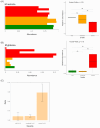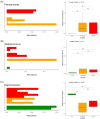Bacteria, Fungi, and Scalp Psoriasis: Understanding the Role of the Microbiome in Disease Severity
- PMID: 39200988
- PMCID: PMC11355785
- DOI: 10.3390/jcm13164846
Bacteria, Fungi, and Scalp Psoriasis: Understanding the Role of the Microbiome in Disease Severity
Abstract
Background: Psoriasis is a chronic skin condition affected by genetic and environmental factors. Changes in the skin microbiome may affect the immune system and skin barrier functions, thereby contributing to the development and progression of psoriasis. The scalp, which is a common site for psoriasis, is often resistant to therapy. Although several studies have investigated the scalp microbiome, analyses focusing on both bacteria and fungi remain scarce. Methods: We examined the scalp microbiomes of 11 patients with psoriasis complicated with scalp lesions and categorized them according to their Psoriasis Area Severity Index (PASI) scores. The bacterial and fungal data were analyzed using QIIME2 pipeline version 2021.04 and the UNITE database version 8.3, respectively. Results: The Shannon indices for mild (2 patients), moderate (4 patients), and severe (5 patients) groups were 0.97, 1.38, and 1.88, respectively. A significant correlation was observed between increased mycobiome diversity and disease severity (p = 4.07 × 10-5, Spearman's correlation: 0.9269). Compared with the mild and moderate groups, the severe group exhibited a higher abundance of Malassezia globosa. Pseudomonas and Staphylococcus were, respectively, more prevalent in the moderate and severe groups than in the mild group. Conclusions: This study highlights the potential role of increased fungal diversity and specific microbial compositions in the severity of scalp psoriasis, suggesting a possible avenue for targeted therapeutic interventions.
Keywords: bacteria; fungus; microbiome; mycobiome; psoriasis; scalp psoriasis.
Conflict of interest statement
The authors declare no conflicts of interest.
Figures





Similar articles
-
Severe Scalp Psoriasis Microbiome Has Increased Biodiversity and Relative Abundance of Pseudomonas Compared to Mild Scalp Psoriasis.J Clin Med. 2022 Nov 30;11(23):7133. doi: 10.3390/jcm11237133. J Clin Med. 2022. PMID: 36498707 Free PMC article.
-
Inferences in microbial structural signatures of acne microbiome and mycobiome.J Microbiol. 2021 Apr;59(4):369-375. doi: 10.1007/s12275-021-0647-1. Epub 2021 Feb 10. J Microbiol. 2021. PMID: 33565055
-
The Effects of Brodalumab on the Fungal Microbiome in Patients with Psoriasis.Int J Mol Sci. 2024 Sep 24;25(19):10239. doi: 10.3390/ijms251910239. Int J Mol Sci. 2024. PMID: 39408568 Free PMC article.
-
Systemic pharmacological treatments for chronic plaque psoriasis: a network meta-analysis.Cochrane Database Syst Rev. 2017 Dec 22;12(12):CD011535. doi: 10.1002/14651858.CD011535.pub2. Cochrane Database Syst Rev. 2017. Update in: Cochrane Database Syst Rev. 2020 Jan 9;1:CD011535. doi: 10.1002/14651858.CD011535.pub3. PMID: 29271481 Free PMC article. Updated. Review.
-
Topical treatments for scalp psoriasis.Cochrane Database Syst Rev. 2016 Feb 26;2(2):CD009687. doi: 10.1002/14651858.CD009687.pub2. Cochrane Database Syst Rev. 2016. PMID: 26915340 Free PMC article. Review.
References
-
- Stern R.S., Nijsten T., Feldman S.R., Margolis D.J., Rolstad T. Psoriasis is common, carries a substantial burden even when not extensive, and is associated with widespread treatment dissatisfaction. J. Investig. Dermatol. Symp. Proc. 2004;9:136–139. doi: 10.1046/j.1087-0024.2003.09102.x. - DOI - PubMed
Grants and funding
LinkOut - more resources
Full Text Sources

